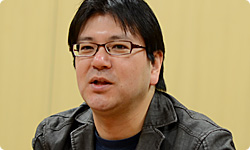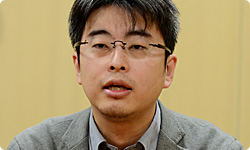3. Getting the Heroines Right
Something I remember clearly from when we discussed Spirit Camera was how impressed the staff at Nintendo who worked on the package artwork were by how particular Tecmo Koei Games were about images of their female characters. Ever since then, I’ve associated Project Zero with cute heroines.
I see! (laughs)
That’s why I’d like to take this opportunity to ask Shibata-san about getting the heroines in the game right, and why cute female characters work so well in a horror setting.
Certainly! (laughs) Well, I’ll respond first to the question of why we chose to use female characters as the main characters in this game. Kikuchi spoke in the previous interview about how we first wanted to design the lead character so that the players could share the protagonist’s fear via that character’s facial expressions.

And it was the natural consequence for you to choose a youthful female character with some kind of sixth sense, or sensitivity to the spirit world.
Yes, that’s right. The majority of the time, there won’t be ghosts appearing, so you’ll be looking at her.
So you are looking at the image of a frightened young woman throughout the entire game. But then you also have games where you spend the whole time looking at a guy with a moustache and a set of overalls, jumping round the place. (laughs)
(laughter)
The movement you’ll see in the centre of the screen is basically always going to be the main character walking with trepidation, and then reacting to things with shock and fear. As we pursued the most idealistic design, in order to make this as subtle and rich in emotion as possible, we eventually came up with that kind of a youthful female character. Also, her less-threatening appearance should clearly tell the players that this isn’t a game where you can defeat your enemies by simply hitting them.
So you use female lead characters because the effect you required led you in this direction. And there was me thinking that it was simply because members of the team liked that sort of image. But when you explain things in that way, I can see where you’re coming from.
Ah, well, it goes without saying that we wouldn’t have put all that effort into getting it right if we didn’t actually like the images themselves. (laughs)
I knew it! (laughs) Well, it seems you’ve successfully combined your personal taste with practical benefits. Our staff at Nintendo were really taken aback by how particular you were about this aspect of the game.
I think that the decision to use female lead characters in the Project Zero series grew naturally from a combination of three factors: their appearance and the mood they convey really suits the story; they work well within the game system where combat takes place using a camera; and they are pleasant for the player to look at.
I see.
A major theme in Project Zero 2 is the symmetry of having a set of twins as the main characters . But for this Wii version, we have actually made the twin protagonists older than they were in the original version.

Comparing the Wii version with the original, they do seem rather different.
We made them a bit more grown up, totally reworking the visuals for everything from their clothes to their facial structure. The idea was to go from the previous ‘cute’ look, to a more adult appearance.
Kikuchi gave a lot of detailed instructions about their faces in particular.
Yes, that’s right. I was especially concerned with getting their lips right.
Yes, he really was! For a decade now, Kikuchi has been very particular about the shape of the heroine’s lips. It got to the point where the team would say, “Not the lips again!” (laughs)
(laughs)
Well, I think that while the eyes obviously play a major role in feminine beauty, the mouth is also extremely important.
Um, I’m not sure if we’re still discussing the game here... (laughs)
I’m sorry! (laughs) Well, something that Shibata was very particular about on this title was the look of the heroine’s shoulder straps.
Well, their clothes fit quite tightly, so we designed it so that the shoulder straps would move, to contrast with that. I thought it would be better if the straps moved from side to side when the heroines ran, and it is summer after all... I’m not sure if anyone will understand what I’m talking about.
Well, I think there will be people who understand, and people who won’t. (laughs).
There is sound reasoning behind all this. In the original Crimson Butterfly, we employed a ‘three-quarter view’7, which meant there were a lot of scenes where you saw the main character from the front. For this title, we altered the camera angle to a third-person view 8. As a result, you see the main character from the back for most of the game. 7 ‘Three quarter view’: The action is viewed from above, at a tilted angle. The viewpoint is fixed, with the floor is displayed at a diagonal angle from the front to the back of the screen. This view was utilised in the first three titles in the Project Zero series. 8 Third-person view: This contrasts with a first-person perspective (where the player sees the same things as the character they are controlling) and means that the player can see the player character at all times. In third-person view, the camera follows the player character, so they are viewed from the back. This was also used on the previous Wii title in the series, Zero: Tsukihami no Kamen.
I see. So this means the view of the main character’s back needs to be capable of expressing a whole range of things.
Precisely. This means that from the perspective of designing the main character’s clothes, we needed to focus more on what was visible from the back. And right at the centre of the screen are her shoulders. That’s why we thought it would be better to have something that moves, which is why the shoulder straps became very important.
So the reason you were so particular about this was that you were thinking of how best to render the main character visually, from a functional point of view. But at first sight, it seems that maybe you were just very interested in her shoulders. (laughs)
(laughter)
Just out of interest, are there many female staff members working on the Project Zero team?
Yes, there are. It varies depending on the project, but on this title, the designer overseeing the twin lead characters was a woman.
Do you get the impression that men and women tend to focus on different aspects of the design when creating female characters?
There certainly is a difference, in terms of the way they approach the task. But I don’t think this actually ends up making much of a difference when it comes to the final result.
I do think there’s a difference in the way male and female designers approach the facial structure of the characters. But in the end, it’s all guided by Shibata’s direction, which means that the final result will be the same.
My view is that there is a difference between male and female designers, to the extent that I think they may be actually seeing different images in their minds.
Well, with clothes design, female designers may be thinking about whether or not they’d actually buy these clothes. That may be the standard they are applying.
Ah, I see what you mean. There might be that filter, a sense of whether or not these clothes meet their own personal standards. Men aren’t thinking of things from that perspective when they consider shoulder straps.
(laughter)
